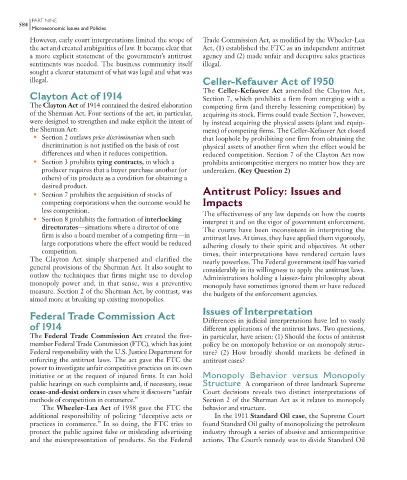Page 675 - Economics
P. 675
CONFIRMING PAGES
PART NINE
584
Microeconomic Issues and Policies
However, early court interpretations limited the scope of Trade Commission Act, as modified by the Wheeler-Lea
the act and created ambiguities of law. It became clear that Act, (1) established the FTC as an independent antitrust
a more explicit statement of the government’s antitrust agency and (2) made unfair and deceptive sales practices
sentiments was needed. The business community itself illegal.
sought a clearer statement of what was legal and what was
illegal. Celler-Kefauver Act of 1950
The Celler-Kefauver Act amended the Clayton Act,
Clayton Act of 1914 Section 7, which prohibits a firm from merging with a
The Clayton Act of 1914 contained the desired elaboration competing firm (and thereby lessening competition) by
of the Sherman Act. Four sections of the act, in particular, acquiring its stock. Firms could evade Section 7, however,
were designed to strengthen and make explicit the intent of by instead acquiring the physical assets (plant and equip-
the Sherman Act: ment) of competing firms. The Celler-Kefauver Act closed
• Section 2 outlaws price discrimination when such that loophole by prohibiting one firm from obtaining the
discrimination is not justified on the basis of cost physical assets of another firm when the effect would be
differences and when it reduces competition. reduced competition. Section 7 of the Clayton Act now
• Section 3 prohibits tying contracts , in which a prohibits anticompetitive mergers no matter how they are
producer requires that a buyer purchase another (or undertaken. (Key Question 2)
others) of its products as a condition for obtaining a
desired product.
• Section 7 prohibits the acquisition of stocks of Antitrust Policy: Issues and
competing corporations when the outcome would be Impacts
less competition. The effectiveness of any law depends on how the courts
• Section 8 prohibits the formation of interlocking interpret it and on the vigor of government enforcement.
directorates —situations where a director of one The courts have been inconsistent in interpreting the
firm is also a board member of a competing firm—in antitrust laws. At times, they have applied them vigorously,
large corporations where the effect would be reduced adhering closely to their spirit and objectives. At other
competition. times, their interpretations have rendered certain laws
The Clayton Act simply sharpened and clarified the nearly powerless. The Federal government itself has varied
general provisions of the Sherman Act. It also sought to considerably in its willingness to apply the antitrust laws.
outlaw the techniques that firms might use to develop Administrations holding a laissez-faire philosophy about
monopoly power and, in that sense, was a preventive monopoly have sometimes ignored them or have reduced
measure. Section 2 of the Sherman Act, by contrast, was the budgets of the enforcement agencies.
aimed more at breaking up existing monopolies.
Issues of Interpretation
Federal Trade Commission Act Differences in judicial interpretations have led to vastly
of 1914 different applications of the antitrust laws. Two questions,
The Federal Trade Commission Act created the five- in particular, have arisen: (1) Should the focus of antitrust
member Federal Trade Commission (FTC), which has joint policy be on monopoly behavior or on monopoly struc-
Federal responsibility with the U.S. Justice Department for ture? (2) How broadly should markets be defined in
enforcing the antitrust laws. The act gave the FTC the antitrust cases?
power to investigate unfair competitive practices on its own
initiative or at the request of injured firms. It can hold Monopoly Behavior versus Monopoly
public hearings on such complaints and, if necessary, issue Structure A comparison of three landmark Supreme
cease-and-desist orders in cases where it discovers “unfair Court decisions reveals two distinct interpretations of
methods of competition in commerce.” Section 2 of the Sherman Act as it relates to monopoly
The Wheeler-Lea Act of 1938 gave the FTC the behavior and structure.
additional responsibility of policing “deceptive acts or In the 1911 Standard Oil case , the Supreme Court
practices in commerce.” In so doing, the FTC tries to found Standard Oil guilty of monopolizing the petroleum
protect the public against false or misleading advertising industry through a series of abusive and anticompetitive
and the misrepresentation of products. So the Federal actions. The Court’s remedy was to divide Standard Oil
9/11/06 4:09:06 PM
mcc26632_ch30_581-597.indd 584 9/11/06 4:09:06 PM
mcc26632_ch30_581-597.indd 584

